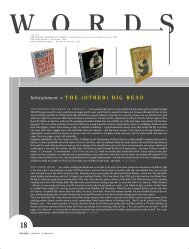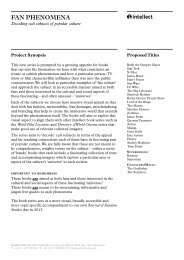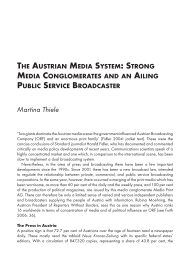Anthem - Intellect
Anthem - Intellect
Anthem - Intellect
You also want an ePaper? Increase the reach of your titles
YUMPU automatically turns print PDFs into web optimized ePapers that Google loves.
Signifying Europe<br />
grave challenges into a carnivalesque celebration uniting highly contradictory<br />
musical elements, the EU anthem simply builds up a climax effect, reducing the<br />
implicit meaning to one of growth and increasing strength.<br />
3. The anthem is normally performed in a considerably slower tempo and with<br />
a simplified instrumentation, texture and timbre compared to the symphony,<br />
resulting in a conventional ceremonial or even sacralised hymn feeling, lacking<br />
the vivid energy that Beethoven inherited from the late eighteenth-century<br />
French revolutionary music.<br />
4. All anthem versions perform the tune in the simplified and more straightforward<br />
form it had in the first parts of the symphony movement, with no real polyphonic<br />
counterpoint and very faint traces, if any at all, of the wilder and noisier<br />
arrangement Beethoven used for the contrasting ‘Turkish’ section. In one way,<br />
this aspect tends to diminish the relevance of Žižek’s comments for the anthem<br />
as such, but on the other hand it verifies that the Oriental representation is<br />
repressed by official EU policies.<br />
5. The devocalising decision to omit the lyrics silences the original narrative element<br />
and paves the way for the much more simple formal arrangement mentioned<br />
above. Some European citizens will remember fragments of the lyrics, at least<br />
the word ‘Freude’ (‘Joy’) that is included in the title of the anthem. Still, the<br />
avoidance of words has important repercussions on what the anthem signifies.<br />
The symphony movement analysis above showed how Beethoven’s music together<br />
with Schiller’s lyrics depicted war-like chaos being silenced by a gathering of forces,<br />
first in tranquility and then developing into a climactic dance: from chaos to harmonic<br />
union and then carnivalesque joy. The original lyrics and music thus combined to give<br />
the communion a Dionysian twist of ecstatic happiness. The orgiastic happiness of the<br />
Promethean ‘fire-drunk’ brothers is much more in line with the self-forgetting desire<br />
expressed in the Europa myth than with Captain Euro’s perfect efficiency—it actually<br />
is reminiscent more of the Captain’s main enemy Dr D. Vider’s carnivalesque circus.<br />
Schiller’s and Beethoven’s praise of universal brotherhood that knows no boundaries<br />
also hints at the hybridity of the classical myth as well as of the egalitarian theme of the<br />
European flag and the motto ‘united in diversity’, though here more as a momentary—<br />
liminal or subliminal—ritual than in any permanent institution-building. But all this<br />
is silenced in the official instrumental version.<br />
It should be remembered that the initial motivation for at all adopting an anthem<br />
was to get a basis for communal ritual activity on solemn occasions such as Europe<br />
Day. When the anthem was finally adopted without lyrics, this gave rise to a strange<br />
176












